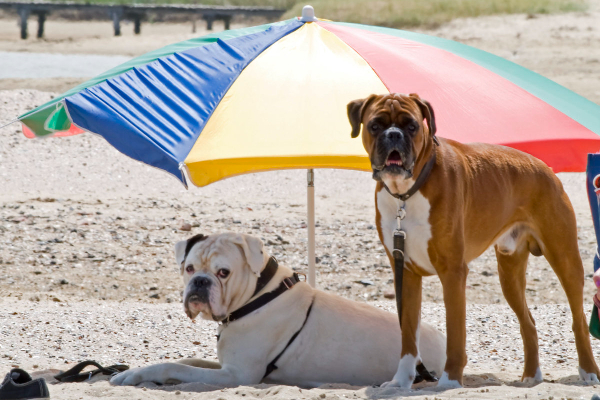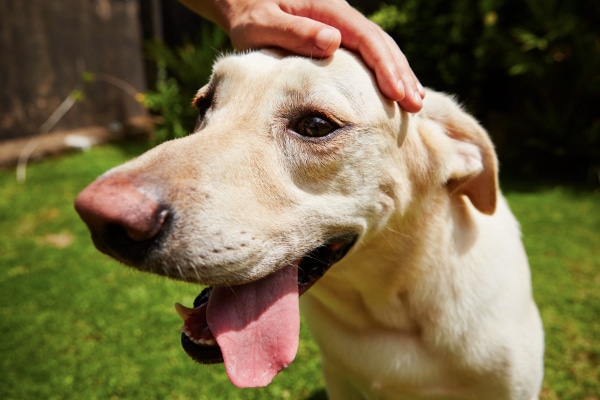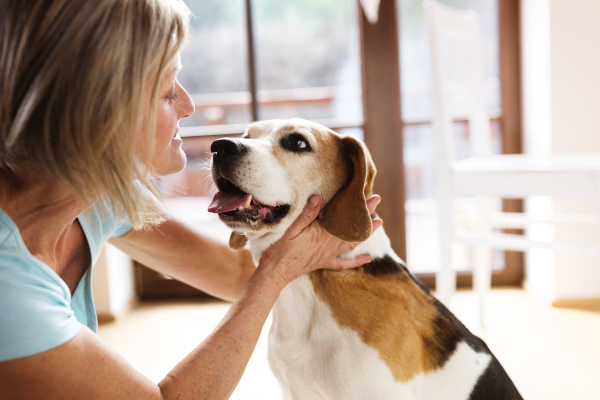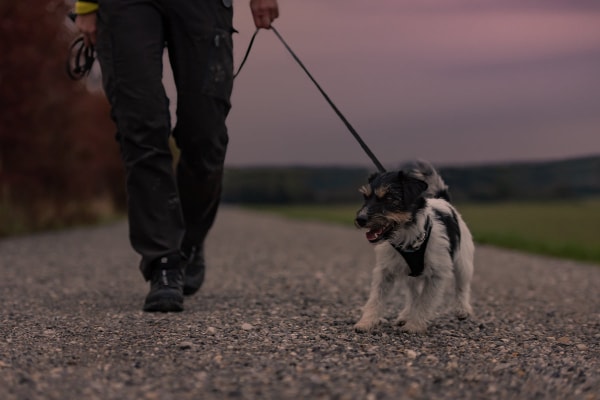Heat exhaustion vs. heat stroke. What’s the difference? To provide a quick reference guide to heat-related illnesses in dogs, integrative veterinarian Dr. Julie Buzby teamed up with emergency veterinarian Dr. Kathryn Williams. Dr. Williams explains the basics of heat stroke and heat exhaustion. And she shares when to go to the vet and how to prevent heat-related illnesses.

“Triage Red: Possible Heat Stroke” echoed over the loudspeaker on a particularly hot day in July. We were already slammed in the ER, but the team leaped into action immediately. They used a gurney to help a 2-year-old yellow Labrador Retriever named Buddy out of the back of his mom’s car.
Buddy was showing signs of severe heat exhaustion—bordering on heat stroke. He was panting uncontrollably and too weak to walk. His mucous membranes were bright red and his lips were drawn back as he panted, showing all of his teeth. When we obtained his dog vital signs, it became clear to us that Buddy was indeed suffering from a heat-related illness. His temperature was 105°F, which is dangerously high.
Chasing tennis balls in hot weather landed Buddy in the ER
The ER team hurried to stabilize Buddy by running cool water over his body, facing fans in his direction, and starting IV fluids to treat dehydration and shock. While we worked to bring his temperature down, one of my vet assistants obtained a history. Buddy’s mom said she had taken him to a cookout at a friend’s house. And when the kids started throwing a tennis ball for him, he couldn’t resist.
In a short period of time, Buddy started stumbling after he chased the ball. He was excessively panting and thick ropey saliva hung from his lips. Eventually, he settled on the ground and was reluctant to move. When his mom tried to relocate him to the shade, he vomited. Buddy’s mom was worried, so she hosed him down with cool water. And then she drove him straight to the emergency room with the air conditioning on full blast.
Heat stroke vs. heat exhaustion in dogs
Buddy was only one of the many dogs who came through my ER for treatment for heat stroke or other heat-related problems each summer. Where I practice in southern Virginia, the high temperatures and humidity can quickly become dangerous for dogs.
Heat-related illnesses occur when the dog’s natural cooling mechanisms become overwhelmed and the body’s internal temperature rises above 102.5°F (normal is 99.5-102.5°F). The first step is the dog overheating and experiencing heat stress. Then, as the body temperature continues to climb, the dog develops heat exhaustion and then heat stroke in dogs.
Why do dogs get heat stroke or heat exhaustion?
Dogs may become overheated for a variety of reasons. But generally, heat exhaustion and heat stroke are either related to exercise (i.e. exertional heat stroke) or to being in a hot environment (i.e. non-exertional heat stroke). Interestingly, people may tend to think heat stroke happens more often to dogs whose parents leave them in hot cars. In a study of 1,259 cases of heat stroke in dogs in the UK, exercise was the trigger 74% of the time.
Any dog of any age, breed, or gender can develop heat stroke or heat exhaustion. But there are certain risk factors that predispose dogs to heat-related illnesses. They include:
- Being overweight or obese (to determine if your dog is in this category, find your dog’s body condition score (BCS))
- Having a dark or thick haircoat
- Being one of the short-nosed dog breeds with flat faces (i.e. brachycephalic breeds)
- Having underlying health conditions such as laryngeal paralysis in dogs, collapsed trachea in dogs, or heart disease in dogs.
- Being in a poorly ventilated location, such as a hot car. (Even if the outside temperature doesn’t feel that hot, or you crack a window, cars can heat up to life-threatening temperatures in a matter of minutes.)

Of the heat-related conditions, heat stroke is by far the most life-threatening. As the body temperature exceeds 106°F, the dog can suffer brain and organ damage, which may be irreversible. However, heat exhaustion is also dangerous, especially for high-risk dogs.
Heat-related illnesses table
Depending on the heat-related illness, dogs may exhibit a variety of symptoms. And since, without taking steps to cool the dog down, overheating turns into heat exhaustion, and then heat exhaustion turns into heat stroke, dogs may start out by showing signs of one condition and then progress to also showing signs of the next.
An overheated dog may be excessively panting and have bright red gums. Sometimes he or she may also be a lethargic dog, reluctant to move or act uncomfortable due to muscle cramps or spasms.
Then, if the dog’s temperature continues to rise and he or she moves into heat-exhaustion territory, the dog may appear weak, vomit, or become less responsive. Due to dehydration, the gums may also be dry.
Finally, as heat stroke sets in, the dog may collapse and begin to show neurologic signs such as seizures in dogs or loss of consciousness. The dog’s gums might be pale, blue, or brown. And sometimes bruises might pop up on the dog’s belly or gums or you might see a dog nose bleed or bloody vomit or diarrhea.
To help you quickly see the difference between the three types of heat-related illnesses in dogs, check out the chart below, and note the disclaimer below the chart, too.
❗️If you think your dog is in crisis, don’t wait, debate, or hesitate. Get to the nearest veterinary hospital or emergency clinic immediately.
Understanding overheating vs heat exhaustion vs heat stroke
| Overheating 🚨 | Heat Exhaustion 🚨🚨 | Heat stroke 🚨🚨🚨 | |
| Excessive Panting | ✔️ | ✔️ | ✔️ |
| Lethargy or reluctance to move | ✔️ | ✔️ | ✔️ |
| Muscle cramps or spasms | ✔️ | ✔️ | ✔️ |
| Abnormal gum color | ✔️ Bright red | ✔️ Bright red or pale | ✔️ Blue, pale, red, or brown |
| Dry or sticky gums | ✔️ | ✔️ | |
| Vomiting | ✔️ | ✔️ May be bloody | |
| Weakness, stumbling | ✔️ | ✔️ | |
| Changes in consciousness | ✔️ Less responsive | ✔️ Extremely slow to respond or unconscious | |
| Seizures | ✔️ | ||
| Abnormal bruising or bleeding | ✔️ | ||
| Collapse | ✔️ | ||
| Body temperature is elevated—anything above 102.5° F is abnormal (Do not solely rely on temperature for decision-making purposes) | ✔️ Below 103° F | ✔️ 103-105° F | ✔️ Over 105°F |
| Require immediate action on the part of the dog parent | ✔️ Cool dog down | ✔️ Wet dog with cool water, turn on AC in the car and head immediately to the ER vet | ✔️ Wet dog with cool water, turn on AC in the car and head immediately to ER vet |
What should I do if I don’t know if my dog has heat stroke vs. heat exhaustion vs. is overheated?
We have tried our best to condense the information into a chart. But determining exactly which category your dog falls into isn’t always black and white.
Therefore, if your dog has developed any of the signs consistent with heat-related illness, the best course of action is to quickly take steps to help cool down your dog and seek veterinary attention.
Quickly take steps to cool your dog down
- Immediately stop any activity and bring your dog inside or to a shady area.
- Rinse your dog with cool water—but remember:
- If you’re using an outdoor hose, let it run first to remove any hot water from the line before spraying down your dog. If the hose is sitting outside in the sun, the water in the line can cause severe burns.
- Do not use ice-cold water or ice baths. The extreme cold can cause the vessels on your dog’s skin to constrict, which traps heat internally. This can be dangerous for your dog.
Seek veterinary attention
While starting the at-home cooling measures, you should also be assessing your dog’s status. If your dog’s signs are mild, you may be able to safely give your dog some time to cool down. But if he or she doesn’t improve or worsen, plan to get your dog to the vet ASAP.

On the other hand, if it seems like your dog may be showing signs of heat stroke or heat exhaustion, or you have any concerns about your dog’s status, immediately make an emergency vet visit at the closest ER or your local veterinarian’s office. And turn the air conditioning on high to help your dog cool down on the way.
❗️Remember, when in doubt, the best plan is to get to the vet as quickly as possible rather than debating with yourself about exactly which heat-related illness your dog has. Dogs can and do die from heat exhaustion and heat stroke, so time is of the essence.
How can you prevent heat exhaustion and heat stroke?
While being able to recognize heat-related problems and acting quickly is certainly important, ideally you would adopt a proactive rather than reactive approach. Whether or not your dog has some risk factors for heat exhaustion or heat stroke, I urge you to take steps to keep your dog cool in summer. To reduce the risk of heat exhaustion and heat stroke:
- Choose cooler times of day (usually early in the morning or late at night) to exercise your dog and provide plenty of rest breaks
- During the heat of the day, limit exercise to small amounts of time outside to use the bathroom
- NEVER leave your dog inside a parked car in warm weather
- Ensure your dog always has access to shade and fresh water
- Ask your vet what additional special precautions you should take to keep a high-risk dog cool and safe

A happy ending for Buddy’s severe heat exhaustion
Thankfully, Buddy’s temperature responded well to cool water, a fan, and some IV fluids. We ran blood work to ensure there was no damage to his organs or abnormalities in his clotting times. Luckily for him, aside from some minor abnormalities associated with dehydration, his organ function and clotting times were normal.
Buddy stayed in the ER overnight on IV fluids to ensure he didn’t develop any complications from his severe heat exhaustion. And when his bloodwork still looked good in the morning, he happily went home with his mom. After this scare, Buddy’s mom said she is going to pay a lot more attention to how long he chases the ball in the heat because it turns out he really doesn’t know when to stop.
Protect your dog from the dangers of the heat
As my patient’s mom learned, an ounce of prevention is worth a pound of cure. Summer’s long days have a tendency to make us want to live life to its fullest. But it is important to be mindful of the fact that the dog days of summer can be dangerous for our dogs.
Hopefully, you and your canine companion get to enjoy a fun and safe summer, free from any heat-related illnesses. But if you are worried your dog may be overheating or have heat stroke or heat exhaustion, act quickly to cool your dog down and get to the vet ASAP.
Recognizing the problem and knowing what to do could save your dog’s life.
How do you keep your dog from overdoing it in the heat?
Please comment below.


We welcome your comments and questions about senior dog care.
However, if you need medical advice, diagnosis, or treatment, please contact your local veterinarian.